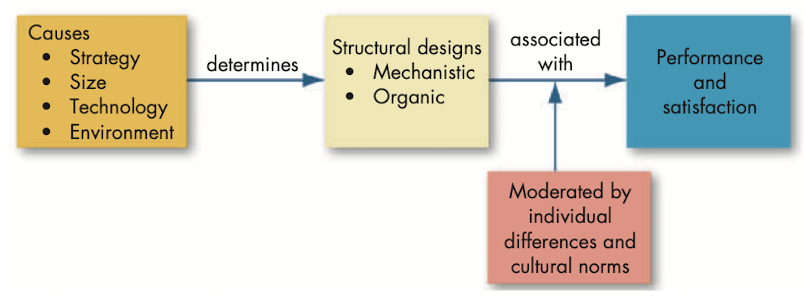
Chapter 15 - Foundations of organization structure
What is organizational structure?
Organizational structure: way in which job tasks are formally divided, grouped and coordinated.
Six elements of an organization’s structure
Work specialization: degree to which tasks in an organization are subdivided into separate jobs.
Departmentalization: basis by which jobs in an organization are grouped together.
Chain of command: unbroken line of authority that extends from the top of the organization to the lowest echelon and clarifies who reports to whom.
Authority: rights inherent in a managerial position to give orders and to expect the orders to be obeyed.
Unity of command: idea that a subordinate should have only one superior to whom he/she is directly responsible.
Span of control: number of subordinates a manager can efficiently and effectively direct.
Centralization: degree to which decision making is concentrated at a single point in an organization.
Formalization: degree to which jobs within an organization are standardized.
Common organizational designs
Simple structure: structure characterized by a low degree of departmentalization, wide spans of control, authority centralized in a single person and little formalization.
Bureaucracy structure
Bureaucracy: organization structure with highly routine operating tasks achieved through specialization, very formalized rules and regulations, tasks that are grouped into functional departments, centralized authority, narrow spans of control and decision making that follows the chain of command.
Matrix structure: structure that creates dual lines of authority and combines functional and product departmentalization.
New design options
Virtual organization: small, core organization that outsources major business functions.
Boundary-less organization: organization that seeks to eliminate the chain of command, have limitless spans of control and replace departments with empowered teams.
Why do structures differ?
Mechanistic model: structure characterized by extensive departmentalization, high formalization, limited information network and centralization.
Organic model: structure that is flat, uses cross-hierarchical and cross-functional teams, has low formalization, possesses a comprehensive information network and relies on participative decision making.
Organizational strategy
Innovation strategy: strategy that emphasizes the introduction of major new products and services.
Cost-minimization strategy: strategy that emphasizes tight cost controls, avoidance of unnecessary innovation or marketing expenses, and price cutting.
Imitation strategy: strategy that seeks to move into new products or new markets only after their viability has already been proven.
Technology: way in which an organization transfers its inputs into outputs.
Environment: institutions or forces outside an organization that potentially affect the organization’s performance.

Chapter 15 - Foundations of organization structure
What is organizational structure?
Organizational structure: way in which job tasks are formally divided, grouped and coordinated.
Six elements of an organization’s structure
Work specialization: degree to which tasks in an organization are subdivided into separate jobs.
Departmentalization: basis by which jobs in an organization are grouped together.
Chain of command: unbroken line of authority that extends from the top of the organization to the lowest echelon and clarifies who reports to whom.
Authority: rights inherent in a managerial position to give orders and to expect the orders to be obeyed.
Unity of command: idea that a subordinate should have only one superior to whom he/she is directly responsible.
Span of control: number of subordinates a manager can efficiently and effectively direct.
Centralization: degree to which decision making is concentrated at a single point in an organization.
Formalization: degree to which jobs within an organization are standardized.
Common organizational designs
Simple structure: structure characterized by a low degree of departmentalization, wide spans of control, authority centralized in a single person and little formalization.
Bureaucracy structure
Bureaucracy: organization structure with highly routine operating tasks achieved through specialization, very formalized rules and regulations, tasks that are grouped into functional departments, centralized authority, narrow spans of control and decision making that follows the chain of command.
Matrix structure: structure that creates dual lines of authority and combines functional and product departmentalization.
New design options
Virtual organization: small, core organization that outsources major business functions.
Boundary-less organization: organization that seeks to eliminate the chain of command, have limitless spans of control and replace departments with empowered teams.
Why do structures differ?
Mechanistic model: structure characterized by extensive departmentalization, high formalization, limited information network and centralization.
Organic model: structure that is flat, uses cross-hierarchical and cross-functional teams, has low formalization, possesses a comprehensive information network and relies on participative decision making.
Organizational strategy
Innovation strategy: strategy that emphasizes the introduction of major new products and services.
Cost-minimization strategy: strategy that emphasizes tight cost controls, avoidance of unnecessary innovation or marketing expenses, and price cutting.
Imitation strategy: strategy that seeks to move into new products or new markets only after their viability has already been proven.
Technology: way in which an organization transfers its inputs into outputs.
Environment: institutions or forces outside an organization that potentially affect the organization’s performance.

 Knowt
Knowt
